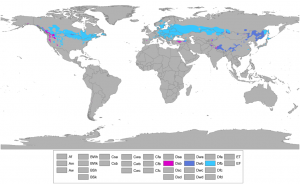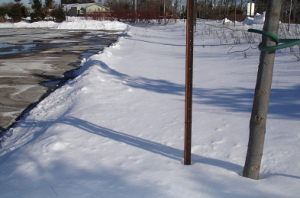Difference between revisions of "Winter"
Jenny Hill (talk | contribs) |
Jenny Hill (talk | contribs) |
||
| Line 16: | Line 16: | ||
To minimize risk of groundwater or soil contamination, the following management approaches are recommended (Pitt et al., 1999; TRCA, 2009b): | To minimize risk of groundwater or soil contamination, the following management approaches are recommended (Pitt et al., 1999; TRCA, 2009b): | ||
Stormwater infiltration practices should not receive runoff from the following areas: | Stormwater infiltration practices should not receive runoff from the following areas: | ||
| Line 22: | Line 21: | ||
*Pollution hot spots (e.g. vehicle fuelling, servicing or demolition areas, outdoor storage or handling areas for hazardous materials, and some heavy industry sites); *Prioritize infiltration of runoff from source areas that are comparatively less contaminated such as roofs, low traffic roads and parking areas; and | *Pollution hot spots (e.g. vehicle fuelling, servicing or demolition areas, outdoor storage or handling areas for hazardous materials, and some heavy industry sites); *Prioritize infiltration of runoff from source areas that are comparatively less contaminated such as roofs, low traffic roads and parking areas; and | ||
*Apply [[pretreatment]] practices before infiltration of road or parking area runoff. | *Apply [[pretreatment]] practices before infiltration of road or parking area runoff. | ||
==Other freezing related concerns== | ==Other freezing related concerns== | ||
Revision as of 16:07, 7 September 2017
Cold Climate[edit]
The majority of Ontario has a "Humid continental" Dfb climate, which includes average temperatures in the coldest month well below -3°C. This condition is found in many other parts of the world where LID strategies are routinely employed, including many northern states in the USA and a large swath of northern Europe. Common concerns associated with the use of LID during out
De-icing Salt[edit]
Sodium and chloride ions in de-icing salts applied to asphalt areas travel easily with the runoff water. De-icing salt can increase the mobility of some heavy metals in soil (e.g. lead, copper or cadmium). This may increase the downstream concentration of these metals (Amrhein et al., 1992; Bauske and Goetz, 1993).
http://www.unh.edu/unhsc/sites/unh.edu.unhsc/files/pubs_specs_info/jee_3_09_unhsc_cold_climate.pdf
Very few studies have sampled groundwater below infiltration facilities or roadside ditches receiving de-icing salt laden runoff have found concentrations of heavy metals that exceed drinking water standards (e.g., Howard and Beck, 1993; Granato et al., 1995).
To minimize risk of groundwater or soil contamination, the following management approaches are recommended (Pitt et al., 1999; TRCA, 2009b):
Stormwater infiltration practices should not receive runoff from the following areas:
- Where large amounts of de-icing salts are applied (e.g., busy highways), or
- Pollution hot spots (e.g. vehicle fuelling, servicing or demolition areas, outdoor storage or handling areas for hazardous materials, and some heavy industry sites); *Prioritize infiltration of runoff from source areas that are comparatively less contaminated such as roofs, low traffic roads and parking areas; and
- Apply pretreatment practices before infiltration of road or parking area runoff.
[edit]
Rainwater harvesting
Freezing temperatures can cause problems with pipes and cisterns exposed above the frost penetration line[1]. This maybe a significant issue for rainwater harvesting systems, including residential rain barrels.
Green Roofs
Somewhat counter-intuitively, the survival of green roof planting is greater in winters with long deep sub-zero temperatures. Being shallow and very exposed to warming sunlight, green roofs thaw rapidly. Frequent freeze-thaw cycles in the early and late winter is associated higher loss of vegetation on green roofs.

